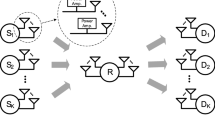Abstract
In this paper, we propose a new mean-squared-error (MSE) minimizing transceiver design method for multiple-input multiple-output amplify-and-forward relay systems with a non-negligible source-to-destination direct link. In earlier works, the direct link has not been fully exploited nor have optimal solutions been presented in analytical forms. Motivated by these weaknesses, we investigated a new source-relay-destination filter design method. To address the difficulties resulting from multiple power constraints and the power allocation between two precoders at the source node, we formulated the MSE minimization problem by introducing a regularizing factor. From the Karush–Kuhn–Tucker conditions of the individual transceiver optimization problem, semi-closed form filter solutions for source, relay, and destination were derived. Then, resorting to the proposed iterative joint optimizing algorithm, a local optimal point was accessible. Through numerical simulations, the efficacy of the proposed method was illustrated, and it was observed that only a few iterations the MSE performances of the proposed method surpass those of conventional schemes.





Similar content being viewed by others
Data Availability
Enquiries about data availability should be directed to the authors.
Notes
With the reference signals from the source and relay nodes, the CSI of \({\mathbf{C}}_1\), \({\mathbf{C}}_2\), and \({\mathbf{G}}\) at the destination node and \({\mathbf{H}}\) at the relay node can be obtained. Additionally, the relay node feeds forward the CSI of \({\mathbf{H}}\) to the destination node. In consequence, all the CSI is available at the destination node.
References
Wang, B., Zhang, J., & Host-Madsen, A. (2005). On the capacity of MIMO relay channels. IEEE Transactions on Information Theory, 51, 29–43.
Tang, X., & Hua, Y. (2007). Optimal designs of non-regenerative MIMO wireless relays. IEEE Transactions on Wireless Communications, 6, 1398–1407.
Munoz-Median, O., Vidal, J., & Agustin, A. (2007). Linear transceiver design in nonregenrative relays with channel state information. IEEE Transactions on Signal Processing, 55, 2593–2604.
Rong, Y., Tang, X., & Hua, Y. (2009). A unified framework for optimizing linear nonregenerative multicarrier MIMO relay communication systems. IEEE Transactions on Signal Processing, 57, 4837–4851.
Liu, X. (2016). Outage behavior of LTE-A with non-identical Rician relay links. China: Nanjing.
Rong, Y. (2010). Optimal joint source and relay beamforming for MIMO relays with direct link. IEEE Communications Letters, 14, 390–392.
Kong, H., Song, C., Park, H., & Lee, I. (2014). A new beamforming design for MIMO AF relaying systems with direct link. IEEE Transactions on Communication, 62, 2286–2295.
Millar, A. P., Weiss, S., & Stewart, R. W. (2013). THP transceiver design for MIMO relaying with direct link and partial CSI. IEEE Communications Letters, 17, 1204–1207.
Wu, C., Chung, W., & Chen, C. (2013). MMSE-based precoder design in nonregenerative relay systems with direct link. In IEEE 77th vehicular technology conference. VTC Spring.
Kong, H., Shin, H., Oh, T., & Lee, I. (2017). Joint MMSE transceiver designs for MIMO AF relaying systems with direct link. IEEE Transactions on Wireless Communication, 16, 3547–3560.
Chalise, B., Zhang, Y., & Amin, M. (2012). Local CSI based selection beamforming for AF MIMO relay system with direct link. IEEE Communications Letters, 16, 622–625.
He, Z., Zhang, J., Liu, W., & Rong, Y. (2016). New results on transceiver design for two-hop amplify-and-forward MIMO relay systems with direct link. IEEE Transactions on Signal Processing, 64, 5232–5241.
Yang, J., He, Z., & Rong, Y. (2017). Transceiver optimization for two-hop MIMO relay systems with direct link and MSE constraints. IEEE Access, 5, 24203–24213.
Grant, M., & Boyd, S. (2014). The CVX users guide, release 2.1. Retrieved from http://web.cvxr.com/cvx/doc/CVX.pdf.
Boyd, S., & Vandenberghe, L. (2004). Convex optimization. Cambridge University Press.
Tse, D., & Viswanath, P. (2005). Fundamentals of wireless communication. Cambrigde University Press
Acknowledgement
This work was supported by the Korea Maritime And Ocean University Research Fund.
Funding
The authors have not disclosed any funding.
Author information
Authors and Affiliations
Corresponding author
Ethics declarations
Conflict of interest
The authors have not disclosed any competing interests.
Additional information
Publisher's Note
Springer Nature remains neutral with regard to jurisdictional claims in published maps and institutional affiliations.
Appendix: The monotonicity of function \(p({{\bar{\mu }}}_1)\)
Appendix: The monotonicity of function \(p({{\bar{\mu }}}_1)\)
Substituting \({\tilde{\mathbf{A}}}_1({{\bar{\mu }}}_1)\) in the function \(p({{\bar{\mu }}}_1)\) with \({\tilde{\mathbf{A}}}_1\) in case 3, the differentiation of \(p({{\bar{\mu }}}_1)\) with respect to \({{\bar{\mu }}}_1\) is written by the following:
where \({\bar{\mathbf{U}}}_A{\bar{\varvec{\varLambda }}}_A^{-1}{\bar{\mathbf{U}}}_A^H=\text {SVD}({\varvec{\varOmega }}_1 {\varvec{\varOmega }}_2 + {{\bar{\mu }}}_1{\mathbf{I}}_{N_s}+\frac{\text {Tr}({\varvec{\varPsi }})-{{\bar{\mu }}}_1 P_s}{P_{r,A}}{\mathbf{H}}^H{\mathbf{B}}^H{\mathbf{B}}{\mathbf{H}})\), \({\varvec{\varSigma }}_A = {\mathbf{I}}_{N_s}-\frac{P_s}{P_{r,A}}{\mathbf{H}}^H{\mathbf{B}}^H{\mathbf{B}}{\mathbf{H}}\), and \({\mathbf{L}}_A={\varvec{\varOmega }}_1({\mathbf{I}}_{N_s}-{\mathbf{D}}_2{\mathbf{C}}_2{\tilde{\mathbf{A}}}_2)\). (27) is obtained by substituting \({\mathbf{L}}_A^H{\bar{\mathbf{U}}}_A{\bar{\varvec{\varLambda }}}_A^{-1}{\bar{\mathbf{U}}}_A^H{\varvec{\varSigma }}_A^H{\bar{\mathbf{U}}}_A{\bar{\varvec{\varLambda }}}_A^{-\frac{1}{2}}\) with \({\mathbf{Q}}_{A}\) which is defined by \({\mathbf{Q}}_{A}={\mathbf{L}}_A^H{\bar{\mathbf{U}}}_A{\bar{\varvec{\varLambda }}}_A^{-1}{\bar{\mathbf{U}}}_A^H{\varvec{\varSigma }}_A^H{\bar{\mathbf{U}}}_A{\bar{\varvec{\varLambda }}}_A^{-\frac{1}{2}}\). Thus, the function \(p({{\bar{\mu }}}_1)\) is monotonically decreasing.
Rights and permissions
About this article
Cite this article
Shin, J. New Mean-Squared-Error Filter Design Method for Multiple-Input Multiple-Output Amplify-and-Forward Relay Systems with a Non-negligible Direct Link. Wireless Pers Commun 125, 3085–3099 (2022). https://doi.org/10.1007/s11277-022-09699-7
Accepted:
Published:
Issue Date:
DOI: https://doi.org/10.1007/s11277-022-09699-7




